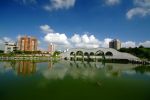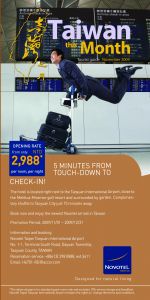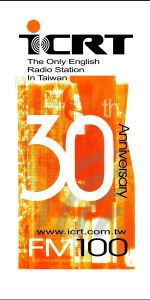
Taichung is the third largest city in Taiwan after Taipei and Kaohsiung, with a population just over one million. Taichung, meaning Central Taiwan, is located on the middle west side of the island which in 2010 going to merge the city and the county to a direct - controlled municipality.
Spread out over the flat coastal plains west of the mountains, Taichung is regarded to be a most attractive place to live in on the island. Taichung enjoys the best year around climate, without the seasonal extremes of heat and cold, clean air, and less crowded compare to Taipei and Kaohsiung.
Taichung traces its origin to a village - Datun, today the site of Taichung Park together with Nantun, the western part of the city, and other places nearby. This explains why old temples and buildings are scattered all around the city. Datun was briefly the capital of Taiwan but in 1894 Taipei assumed the official role.
With less than 1 hour from Taipei or Kaohsiung, with Taiwan High Speed Rail, Taichung is easily accessible. The Taichung Port, provides a wide range of facilities for shipping like warehouse and logistic services to mention a few.
Taichung can be divided into two parts - one old center and one modern part. The old center includes: Central, East, South and parts of North and West district, lies around the train station and is home to many government offices, hotels, shops and traditional food stalls. The modern part of the city: Beitun, Nantun, Xitun and West district includes the business sector and most of the international restaurants, hotels and nightlife.
The city's oldest place of worship, Wanhe Temple, dedicated to Mazu is situated in the modern Nantun district. Not far away from the temple is the unique Fongle Statue Park with many sculptures made of bronze, stainless steel and stone. Across the street lies Lakeside Street Block of Arts, where many tea and coffee shops together with local antique, ceramic and folk art shops can be found. For local handicrafts Nantun Old Street is the best place. Taichung Railway Station, began operating in 1907, and Taichung City Hall are both built under the Japanese time and are still in use. Dining in this part of the city caters more for the traditional setting.
In the North district is the famous Baojue Temple with one of Taichung most popular tourist attraction - the 27 meter - high gold - painted statue of Milefo. In the same part of the city is Confucius Temple and close by is the Martyrs' Shrine. Both of them close to Taichung Park which was inaugurated in 1903 and has played an important role of the city. The Husin pavilion in the Taichung park is the landmark of Taiching. There are 10 hiking trails in Daken Scenic Area, Bei Tun District and it was called "Taichung's Back Garden." The local agricultrual products such as golden cold bamboo shoot from spring to fall and the citrus from winter are not to be missed by gourmands. In the Wenxin Forest Park is the newly built Fulfillment Amphitheater, where many international performance take place. There are two nice night markets in this area: Zhonghua Night Market and Yizhong St. Shopping Area both open late at night and are most enjoyable.
The West district includes the National Taiwan Museum of Fine Arts which reopened in 2004 after renovation due to the strong 921 earthquake 1999. Neighboring Taichung Cultural Center hosts some art galleries which display local art work.
Huamei W. St along the Mayuantou River near by Taijohnggang Rd is the so-called club street and named "Little Europe", offering a wide selection of western restaurants and bars. Not to miss is the famous Suncake, a flat crumbling pastry filled with sweet wheat seed and honey .

